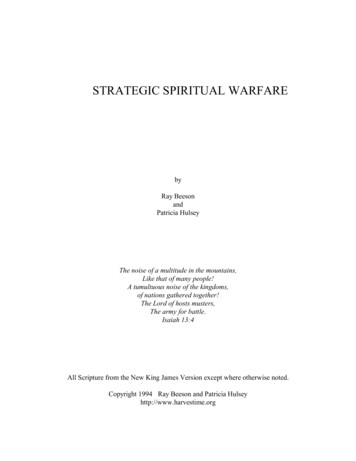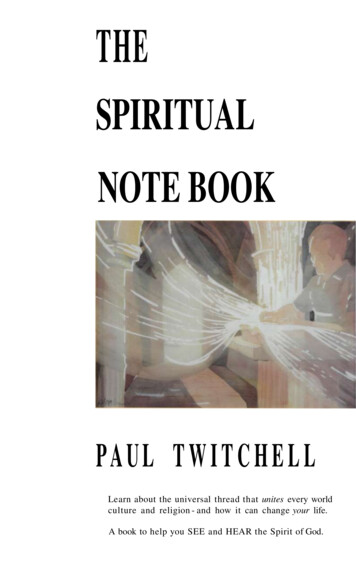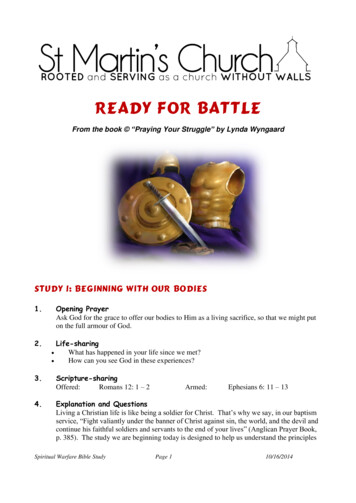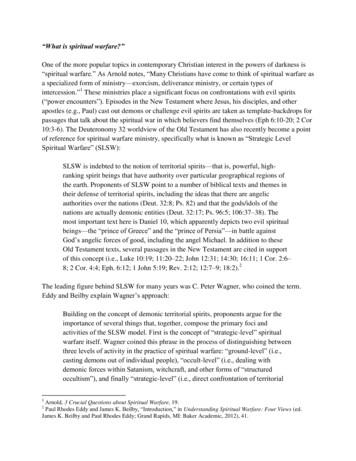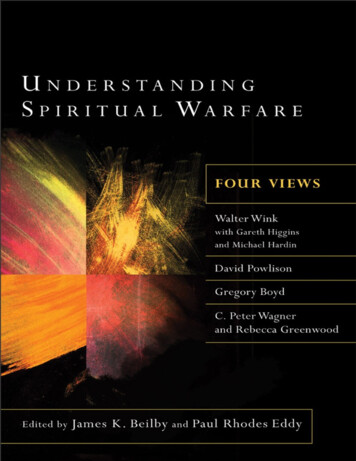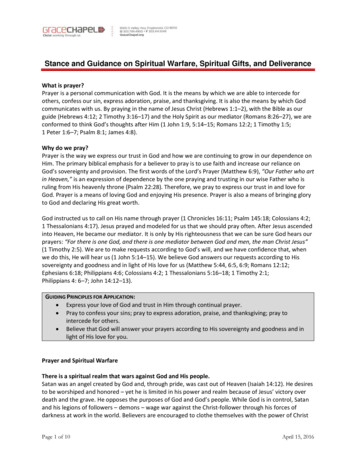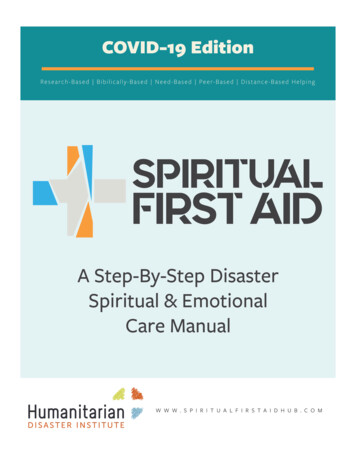
Transcription
Stellenbosch Theological Journal 2020, Vol 6, No 1, 429–456DOI: http://dx.doi.org/10.17570/stj.2020.v6n1.aOnline ISSN 2413-9467 Print ISSN 2413-94592020 Pieter de Waal Neethling TrustThe rediscovery of spiritual practiceswithin ProtestantismGeorge Marchinkowski & Pieter G.R. De VilliersUniversity of the Free StateBloemfontein, South Africapgdevilliers@gmail.comAbstractIn a first part this article investigates the older negative view of spiritual practicesespecially in Protestant contexts. It then spells out the reasons for the growing interestin and reappraisal of spiritual practices in recent times. This development reflects andconfirms a special awareness of their powerful role in spiritual life and illuminatestheir nature and meaning. It further analyses how the growing interest in spiritualpractices is a result of recognising their role in the spiritual heritage that empoweredfaith communities from earliest times and that are not restricted by and to confessionalboundaries. The article, on the other hand, concludes with a discussion of the dynamicway in which spiritual practices are embedded in particular contexts within faithcommunities and, therefore, are also expressed in and through particular confessionalcharacteristics.KeywordsSpirituality; spiritual practices; spiritual disciplines; spiritual formation1. IntroductionConfessional arguments have played a decisive role in criticism of andresistance against spiritual practices. Wakefield (1983:363), for example,wrote about Catholic and Protestant understanding of spiritual practices,“the one will lay more emphasis in our own effort towards God, of unionconsummating purgation and illumination, whereas for the other all is ofGod’s justifying mercy and begins the mystical union, which is the firstwork of saving grace in our hearts”. Key terms in this remark are effort,justifying mercy and grace. Spiritual practices in non-Protestant contextswere seen as attempts to earn grace, that is, obtaining salvation throughmeritorious work and action, which, again, contrasted with the central
430Marchinkowsk & De Villiers STJ 2020, Vol 6, No 1, 429–456Protestant teaching of justification through grace and by faith alone.1Sheldrake (1995:207) expresses a similar sentiment in another, broadercontext, “In fact, until recently, the word ‘spirituality’ was viewed withsome suspicion by Protestants. They preferred terms such as Godliness,piety, holiness of life or the devout life because these seemed less taintedthan ‘spirituality’ with the erroneous doctrine of works-righteousness. Thesituation has changed substantially.”Recent decades saw the need to reflect on such confessional perspectiveson spiritual practices, especially since the renewed interest, also inProtestant circles, in both ancient spiritual practices that existed fromearly Christianity, and contemporary (newly shaped) spiritual practices.It raised the question to what extent spiritual practices reflect or relate to aparticular confessional position, if at all, and also about the relationship ofdoctrine and theology of a particular faith community with its life praxisand spiritual practices. This article will respond to these questions byanalysing contemporary research on spiritual practices by both Protestantand non-Protestant scholars. It will investigate whether and to what extentspiritual practices there are unique features in confessional reflections onspiritual practices.2. A negative view of spiritual practicesProtestant attitudes towards spiritual practices have not always beenpositive. In 1991, a publication of Driskill2 with the title Protestant Spiritual12For a more hostile criticism and for an insight in the cultural wars that define thedebate about spiritual practices, cf. DeWaay (2005:n.p.), “To hear evangelicals likeDallas Willard and Richard Foster tell us that we need practices that were never spelledout in the Bible to become more like Christ or to get closer to God is astonishing. Whatis more astonishing is that evangelical colleges and seminaries are requiring theirstudents to study practices that are relics of Medieval Rome, not found in the Bible, andclosely akin to the practices of many pagan societies.” Rome is for him Catholic Romefrom Medieval times with its ideal to “rule over the world.” He objects against spiritualpractices because, amongst others, they are not prescribed in the Bible, overlookhumanity’s “total depravity”, overestimate human “ability”, and are more “akin toEastern Religion than Biblical Christianity.”Joseph D Driskill is a professor of Spirituality at the Disciples Seminary Foundationat Pacific School of Religion in Berkeley, California, and ordained by the Disciples ofChrist in the USA. He received recognition for his work in Spirituality Studies when hewas elected President of the Society for the Study of Christian Spirituality (SSCS).
Marchinkowsk & De Villiers STJ 2020, Vol 6, No 1, 429–456431Exercises. Theology, History and Practice, was one of the few that hadappeared in the twentieth century within Protestant circles. It is strikingthat his work was to a large extent apologetic in nature, characterisedby an extensive attempt to legitimise itself. It dealt extensively with thediscomfort Protestants feel about matters relating to Spirituality and withspiritual practices in particular. So endemic was this apprehension thatthe book regards this discomfort as virtually “wired” into the DNA ofProtestantism.Driskill explores some possible reasons why Protestants neglect thestudy of spirituality and spiritual practices. One reason is to be found inProtestantism’s traditional areas of strengths that kept Protestants fromappreciating spirituality and its practices. This neglect is a result of morescholastic and puritanical influences that contributed to a preference forfoundational theology with its concentration on divine actions in God’sredemptive work, rather than focus on matters regarding the individual’spersonal relationship with God or response to the gift of salvation. Thiswas a consequence of their high regard for the primary place of the Wordas the locus of revelation and the container of truths for the spiritual life,but also of the conviction that humanity was totally depraved, incapable of“good works”, and, therefore, in no way able to contribute to its salvation.This happened despite the attention to ethical reflection and work ethic,including social action, which tended to overshadow the Protestantconviction that these responsibilities are birthed and formed in a life-givingrelationship with God (Driskill 1991:4). Critical reflection was a strongfeature of Protestantism, influenced by the demands of the enlightenmentwith its emphasis on reason and a rational approach to faith.In tandem with this trend, an analytical paradigm prevailed in thetheological discourse, with a concomitant side-lining of the moreaffective sources and practices of Christian life. Protestantism was oftenuncomfortable with the subjective and the experiential (Driskill 1991:6).Protestantism in its more mainline forms, was critical of a preoccupationwith faith experiences and personal growth and preferred reflecting on theobjective realities of Scripture as the reliable Word of God and doctrine asthe teaching of the church. Driskill (1991:xii) notes these concerns in hisremark that,
432Marchinkowsk & De Villiers STJ 2020, Vol 6, No 1, 429–456believers can affirm the existence of God, the importance of theScriptures and the need to hear the Word in sermons, but discoursethat claims a personal relationship with God at an experientialrather than an intellectual level is largely discouraged.And,The derision mainline Protestants feel about a personal experientialrelationship with God is reflected in their lack of attention tospiritual practices (Driskill 1991:xiii).3Driskill further notes how this aversion to the experiential caused membersto leave their mainline Protestant churches in protest and to join newcharismatic and Pentecostal-type churches, or, also some Roman Catholicgroups where their experience of God was acknowledged, appreciated andencouraged.For Driskill (1991:xvi) this apprehension about spirituality and practicesas faith experienced is ironic when one considers that Protestants do havea spirituality. There is merely a failure to recognise it as such. He furtherrefers specifically to spiritual practices when he notes (1991:xviii) withappreciation that Protestants “have within their own tradition spiritualpractices that are life giving provide a number of alternatives forspiritual growth.”4 These practices encompasses prayer, bible study andwell developed sacramental and liturgical rites.34Note the insertion of “mainline” here. Pietism with its strong experiential nature, wasalways a significant part of some Protestant contexts, but, then, it was a movementthat belonged more to the periphery. The same is especially true of Pentecostalistand charismatic circles that, tellingly, represent one of the strongest movementswithin Protestantism in the twentieth century. Cf. Williams (2016) for a recentcareful analysis of the role of experience, emotions and the subjective in Pentecostalworship contexts. This article, focusing on the therapeutic work through worship in aPentecostal community, illustrates the way in which the body and emotions functionin Pentecostalism. As such, it contrasts sharply with traditional confessions with theirreserved attitude towards the experiential and the body. The article, is however, alsovaluable for its academic insights and its applied research through a case study ofPentecostal worship.Cf. also Sheldrake (1995:207).
Marchinkowsk & De Villiers STJ 2020, Vol 6, No 1, 429–4564333. Reappraising spiritual practicesBefore analysing the reasons for the growing interest in spiritual practicesin recent times, also and especially among Protestants, is discussed, it isnecessary to illuminate what is meant by them. This can best be done bylisting the more salient forms of practices.Such an overview was done early on by Richard Foster, who published one ofthe earliest, books on spiritual practice for an English-speaking Protestantaudience.5 In this bestselling book that sold more than 2.5 million copies, hesystematized practices in a list of twelve different “disciplines” 6 accordingto three categories. The “inward” disciplines comprised meditation, prayer,fasting and study. The “outward” practices were simplicity, solitude,submission and service. The corporate practices were confession, worship,guidance and celebration. Foster (1978:1) named these practices “classic:”they go back to early traditions and were practiced by generations ofbelievers, so that they are “central to experiential Christianity”. With56Richard Foster is a minister, academic and theologian in the Quaker tradition. Hisfirst book, Celebration of discipline. The path to Spiritual growth (1978), which surveystwelve of the ancient spiritual practices, has been reprinted in 1988 and 1998, sellingover one million copies. He has also published Freedom of Simplicity (1981), Money,Sex and Power (1985) and Prayer: Finding the heart’s true home (1992). Foster is anearly marker of the beginnings of contemporary Protestantism’s interest in spiritualpractices.DeWaay (2005) is especially critical of practices because they are called “disciplines”by Foster and, therefore, indicate the contribution of humanity to their salvation. Alsocommon for practices is “exercises,” under the influence of Ignatius of Loyola’s classicwork. Driskill’s book (1991) is an example, of the use of this term. The complexity andrichness of the term, is illustrated in a discussion of Waaijman (2007:7), who speaks of“exercises”, describing them as “processes of appropriation”, but adding that they are“innerly oriented on ‘purity of heart’” as the practical objective (skopos) of spiritualexercises, looking for the receiving of contemplation (telos). A special nature of practicesis illustrated when he links it with the practice of “virtues,” which he describes as“both precondition and essence of spiritual practices; meditation and prayer; mysticaltransformation.” (Cf. further the discussion on virtue below). It is such a link thatshould be kept in mind when one reflects on spiritual practices in a Protestant context– in which sanctification and the fruit of the Spirit are key themes. All this shows thatthe reading of practices in terms of merit, is naïve and uniformed. For other, moresuperficial comments, cf. Tim Keller, a Presbyterian minister (in the more conservativePresbyterian Church of America denomination) on the New Calvinist website /) where the following remark aboutFoster’s work is found: “But his advice is highly dangerous, for those who follow Fosterand seek after an out-of-body experience to make contact with the eternal Creator, maybe opening themselves to occult spiritual forces.”
434Marchinkowsk & De Villiers STJ 2020, Vol 6, No 1, 429–456this description he transcended confessional boundaries, noting thatthey speak to various constituencies. The spiritual practices of prayer andstudy, service and worship would have been familiar to Protestants, whilstsolitude, contemplative prayer, meditation and confession would tend to bemore “Catholic” practices.Foster’s work was soon followed up by other Protestant authors. DorothyC. Bass7 and Craig Dykstra,8, for example, analysed both classic andcontemporary forms of practices. They gathered a group of authors as partof their Valparaiso Project that reflected on various practices that wouldcomplement the traditional ones.9 Their investigations included newerpractices that may sound strange to the uninitiated among Protestants,like honouring the body, hospitality, household economics, saying yes andsaying no, keeping sabbath, testimony, discernment, shaping communities,forgiveness, healing, dying well and singing. They approached their workin a creative manner, modifying some of the practices, like, for exampleconfession that became the practice of forgiveness (Bass 1997:8–12).The same dynamics are to be detected in reflections of Barbara Brown Taylorwho also writes within a Protestant context.10 In her bestselling book, AnAltar in the world. A geography of Faith, (2009), she confirms the significantrole of spiritual practices in the spiritual journey. She also reshapes and7Dorothy Bass, an Evangelical Lutheran, has published widely on this theme. She is theauthor of Receiving the Day: Christian practices for opening the gift of time and co-editorof Practicing our faith: a way of life for searching people and Our way: Christian Practicesfor living a whole life. Two of her books, co-edited, explore the implication of practicesfor ministry and theological education, Practicing Theology: Beliefs and practices inChristian life and For life abundant: Practical Theology, Theological Education andChristian Ministry. Her work thus reflects the ongoing and increasing investigation ofspiritual practices in a Protestant context.8 Craig Dykstra, a practical theologian, born into a Reformed Church of America familyand ordained a Presbyterian, taught Christian Education at Princeton TheologicalSeminary and at Duke Divinity School. He, too, represents the increasing attention tospiritual practices in a Protestant context.9Valparaiso Project on the Education and Formation of People in faith was a projectfunded by the Lily Endowment, situated at Valparaiso university in Indiana, whichsought to encourage the use of practices among Christian congregations of all(Protestant) denominations in the United States of America.10 Barbara Brown Taylor is an episcopal priest and academic at Piedmont College, SouthGeorgia, USA, who has published various books including An altar in the world. Ageography of faith. (2009), Learning to walk in the dark (2015) and Holy Envy: FindingGod in the faith of others (2019).
Marchinkowsk & De Villiers STJ 2020, Vol 6, No 1, 429–456435transforms many of the traditional practices such as discernment, sabbathkeeping and prayer in contemporary ways, while adding more other lesserknown practices such as incarnation, groundedness, physical labourand benediction. Her book is another indication of how comprehensive,creative the approach to spiritual practices has become in Protestantism.It is an approach characterized by an openness to the original practicesand the many and diverse needs of contemporary communities. She takesover traditional material but brings it into conversation with contemporaryculture and with a generation which seeks to commune with the Divineoutside the control and influence of the institutional church.These three examples illustrate the great interest in and openness towardsspiritual practices, and, moreover, the creative attempts to reflect on themand make them relevant for a contemporary audience.4. The power of spiritual practicesFrom the above discussion, it has become clear that the various spiritualpractices have been playing a powerful role in the spiritual journey of faithcommunities. This power is already evident in its potential to generatemany and various forms of spiritual practices that transcend confessionalboundaries. This power is also evident in other key features that deservecloser attention now.4.1. Spiritual practices as a powerful response to a spiritual needSpiritual practices have the ability to speak and respond to a fundamentalspiritual need and desire. The spiritual need is found and exists within acontext of alienation in which faith communities exist. The widely readpublication of Bass and Dykstra, underscores that spiritual practicesshould be understood as a response to the alienation that exists withincontemporary Western culture. They respond to the destructive patternsof living embedded in the contemporary neoliberal capitalist and secularethos and the ravages that resulted from it. They indicate the yearningamong people from such a context for a simpler lifestyle, a lifestyle in whichthere is wholeness, meaningful time and refreshment (Bass and Dykstra1997:x; Bass 2002:16). In similar vein, McLaren (2008:14) describes thepower of practices as helping communities within this experiential reality
436Marchinkowsk & De Villiers STJ 2020, Vol 6, No 1, 429–456to “practice being alive”, training them to see, hear and experience withincreasing consistency and resilience, not just to survive, but to experiencelife in its fulness (McLaren 2008:17).11 Barbara Brown Taylor (2009:xiv)also describes how practices respond to “a longing – for more meaning,more feeling, more connection, more life”. These practices have to dowith spiritual needs of people, reflecting “shared activities that addressfundamental human needs that, woven together, form a way of life”(Bass and Dykstra 1997:xi; Bass 2002:16). They offer an opportunity fortransformation out of this situation and overcoming the alienation causedby it.This aspect, therefore, illustrates an essential characteristic of spiritualpractices. They are so powerful because they are relevant for and efficaciousin the spiritual journey of all faith communities. A spiritual practice isnot merely about a theological or practical reflection or theory, about theexotic and extraordinary, nor about a marginal or ascetic praxis that is theexclusive responsibility of a few, holy people or of church leaders.12 Theyhave to do with the heart of faith, with the deepest spiritual needs of faithcommunities that reflect the desire to overcome alienation and spiritual“dryness”13 and to be transformed into a new way of life within their dailyexistence.The spiritual nature of practices is illustrated by the remark how they“envision a way of life that is whole, a way of life that can be lived withintegrity in our time”, but ultimately the most important aspect is that this11Human beings “yearn for a richer and deeper understanding of what it means to liveas Christian in a time when basic patterns of relationships are changing all around us”(Bass 1997:xiii; see also Norheim 2014:8).12 Dykstra’s early work highlights the harmfulness of individualistic, especially “clergycentric” paradigm which sees the minister up front doing all the spiritual practiceswhile the congregation observe passively. In this respect, he leans on his mentor, EdwardFarley. Dykstra thus argues for a communal model of practice (Dykstra 1991:35–37;also Norheim 2014:17) Norheim further traces the way Dykstra defines “practice” as“an ongoing, shared activity of a community of people that partly defines and makesthem who they are” (ibid:18)13 Foster (1978:xiii) like Driskill (discussed above) believes that spiritual practicesprovided the answer to his experience of a spiritual dryness. After three months in hisfirst parish during which he was left with “nothing to give” to others, he turned towardthe ancient practices as discussed by authors like Augustine of Hippo, Francis of Assisiand Julian of Norwich, among others, and realised (Foster 1978:xiii–xx) that theyprovided the support and sustained believers in their times of alienation and darkness.
Marchinkowsk & De Villiers STJ 2020, Vol 6, No 1, 429–456437is about a life that is “whole, and touched by the presence of God” (Bassand Dykstra 1997:2).14 In this way, spiritual practices are not merely aboutvirtues and about meaningful behaviour. They have a contemplative power,creating a space in which believers can be aware of the unfathomable divinepresence. Ultimately spiritual practices are so powerful because they areabout the mystery of God to which believers are directed.4.2. The dynamic nature of spiritual practicesIt is, secondly, noteworthy that authors on spiritual practices emphasizetheir important place, role and forms for more than two millennia. Oneof the earliest lists of practices attributable to the church, found in Acts2:42–47, include various practices like hospitality, prayer, generosity andworship – all of whom testified powerfully to the integrity and reputationof the church. Also, from an early stage still other practices like pilgrimage,fasting, tithing and lectio divina were prominent in the life of religiousorders and churches. They would, however, eventually also become ahallmark of ordinary Christian existence. They had the power to transformindividuals and communities throughout the ages.15 Through this history,contemporary faith communities are, therefore, brought in touch withChristian traditions in which they are rooted, and which transcendnarrow confessional boundaries. This shared history paves the way foracknowledging and celebrating the common heritage of all contemporaryfaith communities.This desire to honour the sacred traditions of the past as the way to cope withalienation, reflects an awareness across confessions of their transformationalpower. Both Protestants and non-Protestants confirm this power. DavidPerrin,16 a Roman Catholic scholar, for example, writes (2007:267) aboutthe ongoing relevance of traditions behind spiritual practices, “Spiritual14“Craig Dykstra argues for the use of Christian practices and claims that consumerculture has made the church unable to recognise and meet the (spiritual) hunger formeaning. In other words, consumer society has made the construction of the Christianself, something dubious and ambivalent” (Norheim 2014:16).15 Bass and Dykstra therefore assert (1997:8; 2002:26) that, “practices are done incommunity over a period of time”.16 David Perrin, a Roman Catholic priest, professor of Theology at Saint Paul university,Ottawa, Canada, and later President of St. Jerome’s University in Waterloo, Canada, isknown for his important research on St. John of the Cross. He is also known for this
438Marchinkowsk & De Villiers STJ 2020, Vol 6, No 1, 429–456practices are passed along in the forms of traditional rites, songs, readings,particular types of social outreach, along with countless other waysin which people have creatively constructed, expressed, explored, anddeepened Christian spiritualties.” There is not only a connection with pastpractices. The present-day believer is also actively involved in the broadand sweeping communal ancient rites that are practiced drawing near toGod. They invite people to tell each other the stories of faith and to explainwhy they do the things they do.17 It is not merely about remembering thepast or about historical information. The historical past is brought into“active dialogue with the present” (Perrin 2007:268), thereby allowing boththe past and the present to be both challenged, transformed and enriched.It is, therefore, clear, that faith communities appreciated the powerful roleof practices in their spiritual journey.A significant aspect of this transformational power of practices throughoutits history, is their dynamic nature. Practices are not static in the sense ofbeing merely repetitive of ancient practices. A specific practice from thepast might, for example, be considered unhelpful or irrelevant in a differentcontext or group. Spiritual practices are, therefore, more than merelytraditional activities that should be “kept” and “obeyed.” They are indeedtaken over as part of the church’s heritage, but they are also modified,changed and adapted because of new contexts and participants that seek toexperience the divine presence in terms of their particular situation. Thelatter remark is of utmost importance because of it reveals a salient aspectof their power: practices have an inherent power to reinvent themselves inthe ongoing transformation of the spiritual life,18 because they are about“constituent elements in a way of life that becomes incarnate when humanbeings live in the light of and in response to God’s gift of life abundant”more accessible book, Studying Christian Spirituality (2007), which is the outcome ofhis long involvement in teaching spirituality to university students.17 Perrin (2007:268) uses the example of the Roman Catholic practice of honouringthe Sacred heart of Jesus, a late seventeenth century devotion, which many no longeruphold. When this devotion is understood in its historical context, as a call to “giveone’s heart to Christ”, it makes a lot more sense.18 Examples of such new or reshaped practices are contained in Taylor (2009). Theseinclude the practice of “wearing skin”, the practice of “walking on the earth” and thepractice of “getting lost”. Bass and Dykstra (1997:20) state, “A practice can be almostany socially meaningful action” and should not be confined to the ancient exercises thatwere a part of monastic life or ascetic contexts.
Marchinkowsk & De Villiers STJ 2020, Vol 6, No 1, 429–456439(Bass and Dykstra 1997:21) – and this happens in all times and places in amost relevant and powerful manner.4.3. The individual and communal nature of spiritual practicesIt is an important characteristic that spiritual practices are pursued inthe first instance by individuals for their individual journey of faith, ashas already been suggested by some of the remarks above. Some authorscorrectly note that this should not be confused with an individualisticlifestyle as if spiritual practices are exclusively individualistic. It is truethat “practices are embodied by individuals” (Perrin 2007:269) and areundertaken by individuals alone, often and mostly in solitude, seekingconnection with the Divine. And the many forms of spiritual practicesconfirm the individual nature of these practices. The mystical tradition isfull of examples of individuals who practiced various forms and styles ofprayer and meditation that yielded fruit for themselves and promoted theirspiritual growth.All this should, however, not negate or underplay their communal nature,context and consequences of spiritual practices. Spiritual practices are donealso cooperatively; people can undertake them together as a community,and as such, they flow from or benefit the whole community.19 Spiritualpractices such as worship services, baptism and bible studies are also theactivities of communities. In addition, spiritual practices are the result ofand promoted through the spiritual guidance and direction of churches.Individual experiences produce fruit, not merely for themselves, but alsofor their communities, past and present. The individuals’ participationin inherited practices is, furthermore, affected by a communal settingbecause they are informed by the worldview and faith convictions of thecommunities of which individuals are members. This aspect of spiritualpractices is important because it addresses the concern they are aboutindividual and subjective experiences that privatise religion. They have,19Dykstra (1991:319) points out that when people are engaged in the spiritual practiceof prayer, they may be doing so by themselves, but they are involved in a “coherentand complex form of socially established cooperative human activity.” The interplaybetween individual and community is dynamic. The community forms the practice, theindividual practices, the tradition is formed and passed on. Perrin (2007:270), similarly,and insightfully remarked, “Christian practices are always in communion with others– even if those others are not physically present.”
440Marchinkowsk & De Villiers STJ 2020, Vol 6, No 1, 429–456therefore, the power to influence the spiritual life of communities in a mostcomprehensive manner.4.4. The material nature of spiritual practicesSpiritual practices find their power also in their embodied nature. In thisregard it is of major consequence to understand what is meant by the notionof “spiritual” in spiritual practices. Sheldrake, in a concise reflection on thenature of spiritual practices, defines (2005:502) them as “ways in whicha particular spiritual vision is both expressed and facilitated in patternsof behaviour, rituals, prayer or other religious disciplines.”
2 Joseph D Driskill is a professor of Spirituality at the Disciples Seminary Foundation at Pacific School of Religion in Berkeley, California, and ordained by the Disciples of Christ in the USA. He received recognition for his work in Spirituality Studies when he was elected President of the Society for the Study of Christian Spirituality (SSCS).

